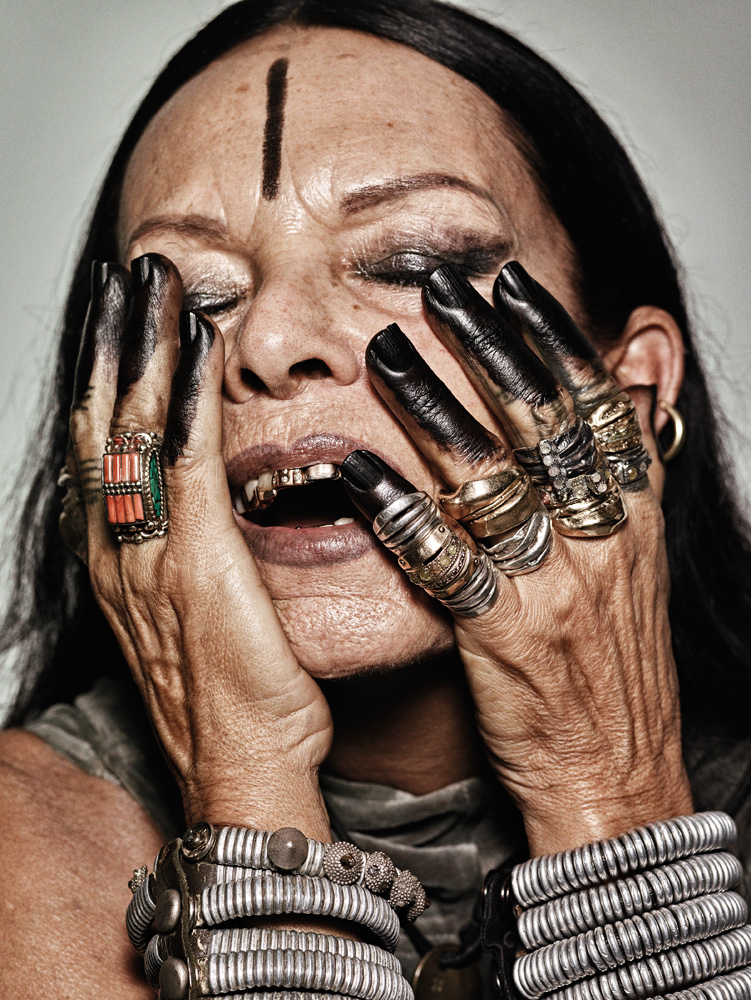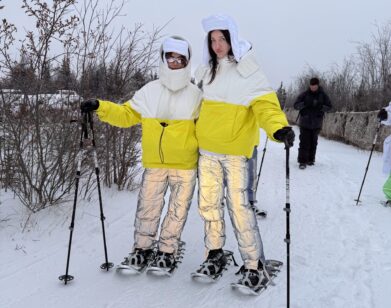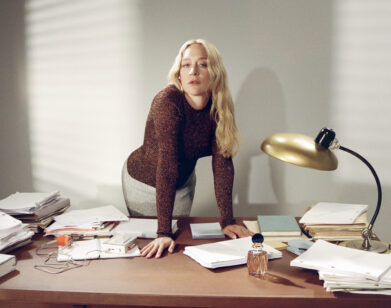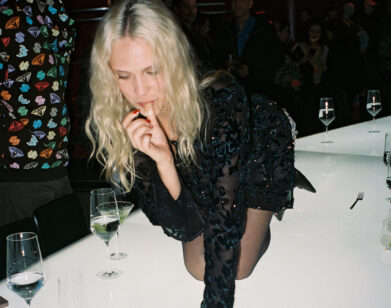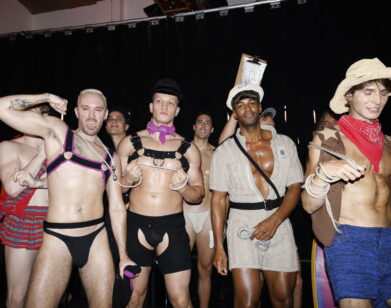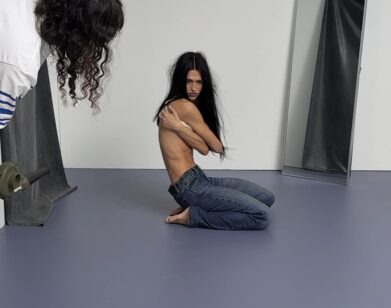Michèle Lamy
Michèle Lamy is walking along a side street in New York’s Chinatown, wreathed in cigarette smoke. The late-morning light from a bright, clear November sun is hitting that smoke with sort of a film-noir effect—slowing it, illuminating it as if from within. We have just had dim sum, and in the moments while we await her chauffeured car, Lamy is deep in thought, plotting for the future probably, as she always is, making plans, troubleshooting those plans, imagining new scenarios, thinking up stories to tell. Maybe she notices the smokescreen she has created. Certainly she can feel it, and she begins to sort of play with it, shifting in the lacy arabesques around her, sliding behind them, disappearing from view, and then stepping forward again, a new plan in mind.
As long as I’ve known her, Lamy has appeared to me this way—slightly hidden, shaded, or obscured from total clarity. For much of that time, I have suspected her of cultivating that effect, deliberately toying with the opacity of her image, making herself into a kind of living Rorschach, about whom everyone might have a different understanding. She loves that when visiting New Mexico, say, she was often mistaken for Navajo; when in Marrakesh, Bedouin; or in her native France, Arab. I’ve wondered if she speaks too with purposeful ellipticalness. When I first met her, and worked as a maître d’ at her restaurant Les Deux Cafés in Hollywood during the late 1990s, we talked about our mutual love of Jiddu Krishnamurti, and so I began to think that Lamy’s often cryptic, dusky English was meant, like Krishnamurti’s knotty and indecipherable writings, to repel my understanding unto the point of some spontaneous and perhaps even unrelated epiphany.
Over the years, I have come to appreciate and celebrate Lamy’s elusiveness, collecting along the way the many myths and gossip spun about her like those threads of smoke. Not long ago, I wrote that it has been suggested that, “She’s Algerian, a Gypsy; she was born in a resistance camp in occupied France, was raised by wolves in the Ardennes; she’s an arms dealer, a vampire, a witch, and she’s 1,600 years old (the number is consistent, as if it were exact, vetted by a team of experts).” More often, and more recently, Lamy is described, no more comprehendingly, as a muse—to her husband Rick Owens and others, like FKA Twigs, who cast her in her short film M3LL155X—or as a collaborator, which sounds like a criminal complaint.
But even if what she does and the way she does it—whether within the company that she and Owens created 21 years ago, or in the projects she creates with her eclectic set of friends and at various art fairs around the world—is confoundingly difficult to describe, it is really rather extraordinary. So it is worth getting at least a few principal points straight: Lamy is in fact 71. She was born and raised in the Alps, near Oyonnax. In Paris, during the ’60s and ’70s, she worked as a defense attorney and as a cabaret dancer, though not, alas, at the same time. In 1979, Lamy moved to Los Angeles, and over the next 24 years, she proceeded to marry, have a daughter (the artist Scarlett Rouge), divorce, create a cultishly adored clothing line called Lamy (hiring, in the process, a talented pattern cutter by the name of Rick Owens with whom she would fall in love and later marry), and then open two landmark restaurants in Hollywood (Café des Artistes and Les Deux Cafés). In 2003, Lamy and Owens moved to Paris and began building their now widely celebrated world there. And that really is the crux of both of their works—world building. And so heavy has been their dual impact that it is becoming hard to tell where their world ends and ours begins.
Within Owenscorp, Lamy functions as a kind of foreman, instigator, and all-around special-projects director. She works very closely with the artisans in constructing the furniture, for example, as well as on the jewelry and housewares. But titles are sort of beside the point for Lamy, who prefers to think of herself as an entrepreneur anyway. Her recent creations at Frieze and the Barbican in London, as well as at her upcoming thingamajig at Art Basel Hong Kong this March, could ably be described as pop-up installations, or happenings, in the good old Situationist tradition. At the Biennale in Venice last May, to take one, Lamy gathered a typically diverse assortment of her friends and co-conspirators on a barge for a kind of three-day summit. Below decks, in the recording studio (née engine room), Lamy recorded songs with UNKLE and A$AP Rocky, while on the topside, she and artists and editors from around the world dined in the restaurant amid various installations, kibitzing about art and life and everything and nothing at all. This kind of open-air, open-ended salon is emblematic of Lamy and of her floating global circus. In her life and work (as if one could separate the two), Lamy seems intent on building safe havens, bringing people together, and waiting for the magic to happen.
CHRIS WALLACE: We were talking yesterday about a picture of you that we’d found, and your assistant looked at it and said, “Oh, I can tell that this is from this year, because the jewelry is different.” He could tell in what era it was taken by what you were wearing. Which is very appropriate because you seem to sort of wear your stories and experiences like the jewelry and little talismans that you collect.
MICHÈLE LAMY: You know, everything has a story. There are these friends we have that are a tribe of Jewish-Russian antiquaires—they have been in Paris since the 18th century with their cabinets de curiosités—so they are in these big places, and we have fun with them. Now, one of their sisters was trying to start a store of vintage clothes, like [the e-commerce vintage store] Byronesque. So I go see her at one of their places at the flea market, and she has a velvet dress from Rick that she bought in L.A. in, like, 2000. She said, “This cost me enough to go to L.A., Paris, or Spain, so I won’t give it to you, but I can sell it to you for 2,000 euro.” I don’t know for which reason I didn’t buy it on the spot, but then I’m telling Rick about this, and then I go to L.A. for the first time since we left, and I realized that I came to L.A. the way I was dressed when I left. Because Rick just did these velvet dresses …
WALLACE: So you don’t change! Or, you come full circle. You know, Scarlett said that she found a Lamy dress from your line in the ’80s, in a vintage store in Palm Springs, and she too didn’t buy it, for whatever reason. But you hardly have any of those old pieces, right?
LAMY: Yeah.
WALLACE: So all of these things are out there—these little stories that you have both seeded into the world. But you collect something else: people, maybe, and experiences …
LAMY: Yeah! But what is the most funny is that we are all going, “Wahhh!” about the dress. And then I buy it and it disappears from the house.
WALLACE: Wow.
LAMY: And after that I told Rick, “A-ha! This is why you didn’t want me to buy this.” [Wallace laughs] But they all tell a story. I’ll tell you a story, with him, but it could be with something else—the jewelry [Lamy designs the Hunrod collection with Loree Rodkin] or something. But that was funny because, when we were taking the pictures with Sorrenti, I thought, “This is not the same velvet dress, but it’s the same spirit.”
WALLACE: Right. Something people don’t know about you, and I think maybe you are a little shy about it, is your memory. You have the most incredible memory, for people and, of course, for stories. But it’s not like some enormous weight of history and friendships and belongings is bogging you down. You feel very light.
LAMY: No, I have to place everything with other people. I don’t keep anything.
WALLACE: That’s the nomad in you.
LAMY: If it doesn’t evolve into something else, something safe, I don’t take it or I lose it or I give it away. When something’s coming … [she makes an expression like clearing the decks] But perhaps what I want to say with this dress is that it was so amazing that this woman had found it right before I returned to L.A.—nothing was related, but it made it all related. So I really believe that, if you follow your instinct, there is some kind of destiny.
WALLACE: Rick said something interesting about the way people are drawn to you and how that lights you up. He said that maybe you’re the mother hen, that you build a place for people to nest and grow and do their thing. Does that seem like an appropriate description? Is that a maternal thing, the gathering of people?
LAMY: For me, it’s not this. You know, it’s like when somebody seems unique, we want to exchange with them and see what’s going on and drink and talk … For example, there was a dinner for Ugo Rondinone, and we start talking. He lives near the New Museum, and he was having breakfast every other day at Gemma, at the Bowery, and so we made a date to meet for breakfast, without exchanging any numbers or anything. I met him, I knew his work; it seemed to me part of a story. I don’t know what we will work on, but we talk to each other, and I’m thinking, “I want to go some way with them.” And if we can do something together, we will see. So I don’t see it as maternal.
WALLACE: You want to take an adventure with these people and then have, like, a souvenir from your travels.
LAMY: No, it’s not about a souvenir. I feel that one day there will be something we want to do together.
WALLACE: Well, it is interesting, and I’ve tried to explain what you do to people—well, I’ve tried to explain it to myself …
LAMY: We don’t try to explain it. I don’t know why …
WALLACE: [laughs] Does it bug you that you’re always classified as, simply, a muse?
LAMY: I don’t like the name muse, but only because of the man and woman thing. If it were as easy to describe a man as a muse, I wouldn’t have a problem with it. Right now, I’m probably at peace with this. And I embrace what we are doing. I’m a facilitator. Because we talk about what we do with Rick … I found the right people to do the furniture. I’m very much a constructor or imagining a story; that is not a muse. I’m more an entrepreneur; that’s what I am.
WALLACE: You said something to me during the Biennale in May that I thought was amazing. You said that there is competition between you and Rick. I mean, you were partly joking …
LAMY: Yeah. “You do this?” Boom. “I’m doing that.”
WALLACE: I love that, the idea that the two of you are having a playful, one-upmanship sort of competition.
LAMY: Yeah. There are things that we start together, that are done together. Because, to me, it’s more like a company—with his name on it, of course—but it comes from a lot of elements. I always like imagining, “Ah, he did this; I’m going to do that.”
WALLACE: So it’s not as if there’s an end plan, a grand body of work you are building. Each little project has its own shape, like a story—its own beginning and end.
LAMY: I think I told you on the barge that now I want to imagine how life is. I always think about the future. While we were shooting the pictures, I was thinking that perhaps I am going to change my barge in Hong Kong. So the exact thing is those One Thousand and One Nights—I like to invent my life. So you make yourself up. Sometimes you have to compromise, because you live with somebody that is interesting. You can go within your dreams. So it is One Thousand and One Nights, and I’m sure, somewhere, I think I’m going to get killed if I stop telling stories. I don’t want any other explanation. I’m always excited. Every day, every morning. I wake up like, “Ah, you can do this, you can do that …” I have such a joy for the world.
WALLACE: Does it come from people, the joy?
LAMY: Imagining. I’m never afraid.
WALLACE: Yeah, that’s the thing. Scheherazade telling her stories in One Thousand and One Nights is trying to fight off death. That seems to me to be about fear, whereas you seem to be hungry for everything.
LAMY: Yeah, but I think the fear of getting the cut is very subconscious. Even in the story you say that this happened, that happened; you don’t think about the sword. It’s definitely something that is there, but we say it as a joke. It is not what I experience.
WALLACE: You also like being able to tell the story in very different ways, different places. You like to be present, but then also recede. You’re always pleased if, say, you’re in New Mexico, and you’re mistaken for a Navajo—
LAMY: Exactly. I like that.
WALLACE: You like to pick and choose how present you are.
LAMY: That’s why I’m bored with novels and I like poetry. I like music because it starts a story; you can invent, dream. There is no beginning, no end. It’s what I don’t like: to mark the time. I’m terrible with the time. Even for myself I often don’t remember if I am 25 or 82. I don’t like this way of thinking: “We did that and then that and then that.”
WALLACE: Another thing about a novel is that it explains everything, whereas poetry leaves it open, you’re allowed to interpret. And I feel like you sort of invite other people to be a part of the experiences you create—like, their interpretation of what it is that we’re doing is a part of what is going on. You invite other people’s creativity into it.
LAMY: I want to get into their brain.
WALLACE: [laughs] You know Brian Eno? He has this idea about what he calls “scenius.” So one person can be a genius, but a group of people—a group who are collectively a part of a scene—they can have or be scenius. So, like, the Beat poets or the Lost Generation, because they are friends with one another, lift each other up and are greater than the sum of their parts. Do you feel as though you and your tribe are this kind of an organism working together? Or are you really a part of a group, a scene?
LAMY: I don’t know. There are a lot of little scenes. Because it’s not like the poets or the painters are working together. It is more in the mind.
WALLACE: I know there are people from whom you’ve drawn inspiration, historical people …
LAMY: Yes, of course.
WALLACE: Who are the people whose lives dazzle you? And what was it about them that enchanted you?
LAMY: At the same time, I can be very jealous of someone like Louise Bourgeois, because she concentrated on her thing and I don’t. But as she expressed it in her way. I’m jealous of Peter Beard because he went all over the world doing his thing …
WALLACE: I always think, though, that if somebody who’s really mellow decides to be a boxer, or somebody who’s really hyper does yoga, it doesn’t fit; it’s not going to work. And I feel like you know precisely who you are and you live in a rhythm with that. You couldn’t go be Louise Bourgeois, locked in a room without people. You would go insane.
LAMY: Perhaps I just need a restaurant that big. [laughs]
WALLACE: With a big spider in it. [both laugh] Well, we used to joke that the restaurant was theater, and now the things like the barges, which are kind of theater, are also restaurants.
LAMY: Yeah, I have to go that way. So this is like the mother side. But I don’t feel it as a mother side; I find it extremely interesting, chic, when you are getting food and you are talking. I feel that is very important.
WALLACE: And you light up. Like an impresario who has a hit show—the moment when they see the audience go crazy—you don’t even have to be in the conversation; I can see you getting high from other people getting excited. It’s a particular vicarious joy that you take from it. So in a weird way, it makes me feel like you are both creator and audience of what you do.
LAMY: Well, okay, voilà! That is it precisely.
WALLACE: One of your planned projects is to gather a group of influential Palestinian and Israeli women together, perhaps on one of your barges, and through their dialogue create a different sort of dialogue within the region … you know, just generally change the world.
LAMY: If we could understand why the civilization that was so interesting for 20 or 30 centuries is coming to this—I mean, it’s [chaos, warfare] every day… People are contacting me, trying to make plans. But the thinking is that, when we sit around a table, we can be like this [cordial, considerate], so why are we being like that. I’m attracted to these stories because they are the source of all of our traditional stories … So in part, it’s the Egyptians that started all that shit because, before, people had thousands of gods, doing their stuff with gold. Nice statues. And then which one was it who decided there’s one god?
WALLACE: Oh, yeah. Sun Ra? Akhenaton? Sheesh. Sure, yeah, him.
LAMY: Yeah. And from then on, it is everyone trying to say, “But my god is the best.” Is that the most silly thing in the world? That determines the culture. And after that, it’s all about the money. And you think about the time, they could have been so happy … Gods for everything.
WALLACE: The god of the tea, the god of …
LAMY: Lightning. And that lasted for, like, 20 or 30 centuries.
WALLACE: The good old days.
LAMY: You know, there are so many things that are so interesting, whether it’s the discovery of the DNA and people fighting whether that bone they dig up is 300,000 years old, or older. And then you have these people who say they don’t believe in evolution and that they want to be president of the United States …
WALLACE: And the Earth is 6,000 years old.
LAMY: Okay, so how do you get them to understand?
WALLACE: Well, you bring them to your table. But you seem so hopeful for the world. You’re the least cynical person I know. You don’t seem like, “It’s Armageddon.”
LAMY: But there are some times when you feel like it’s so absurd to stop, you have to be very optimistic. I think I know the difference. I mean, I’m not crazy.
CHRIS WALLACE IS INTERVIEW‘S SENIOR EDITOR.

